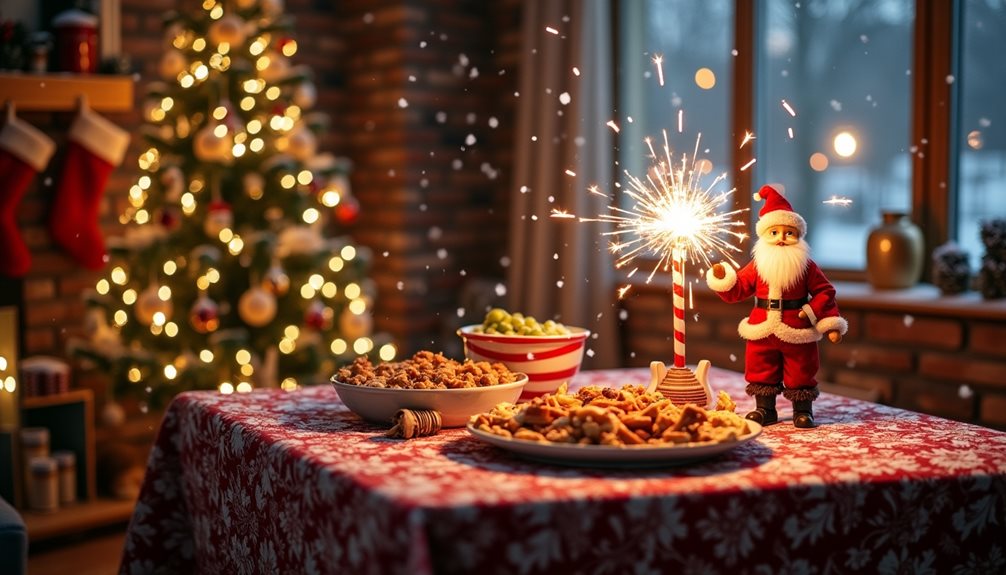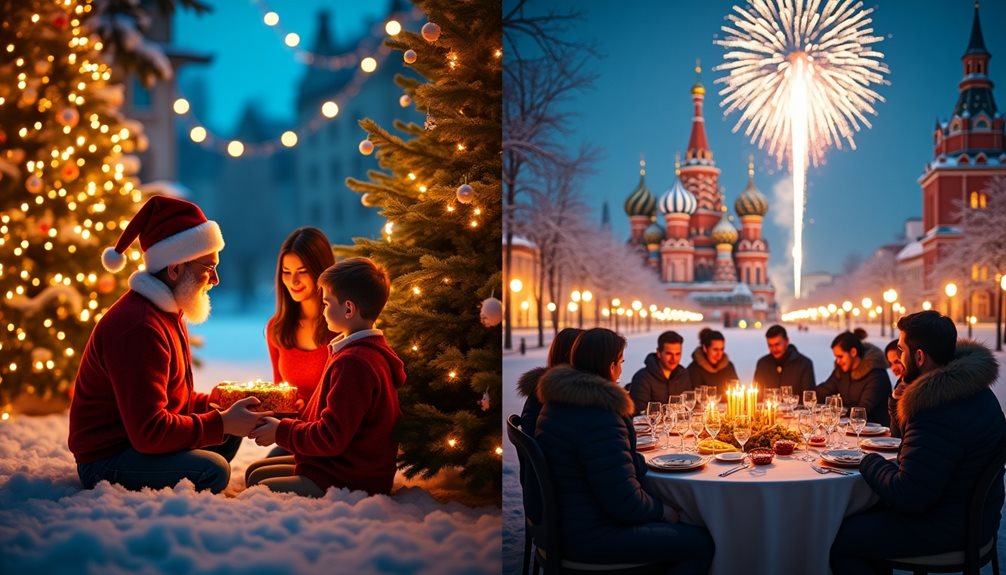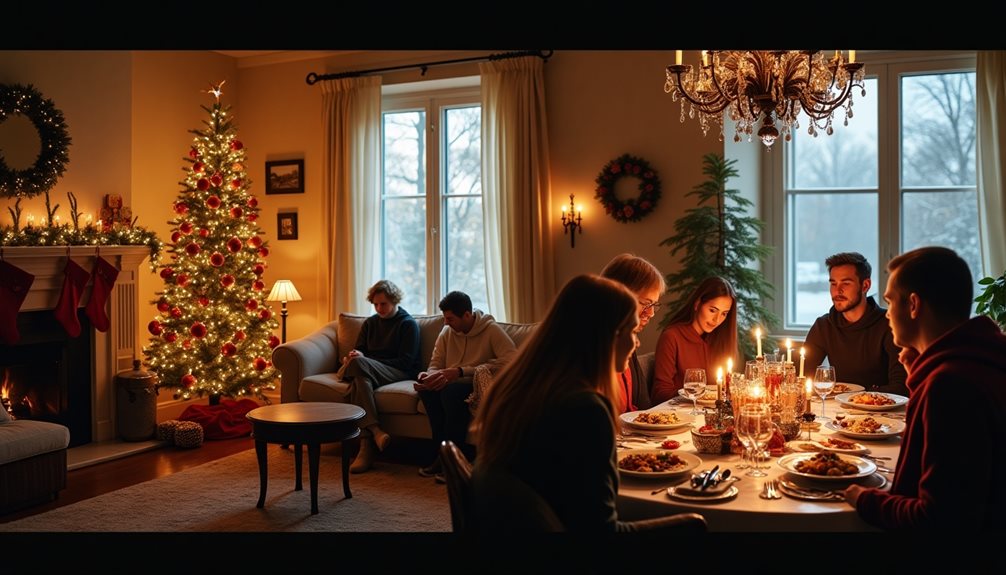When considering winter holidays in Russia, the festive season is marked by a rich tapestry of traditions and celebrations that extend beyond Christmas and New Year’s Eve. These holidays reflect cultural, religious, and historical influences, creating a unique atmosphere during this time of year.
Winter Holiday Season

In exploring Christmas dates and traditions, it’s fascinating to observe how these celebrations differ between the USA and Russia.
In the United States, Christmas is celebrated on December 25th, aligning with widespread Western customs. You’ll find vibrant decorations, caroling, and a focus on gift-giving, all wrapped in a sense of freedom and personal expression. The holiday meals here are a feast for the senses, often featuring turkey, ham, and a variety of desserts like pies and cookies, reflecting a rich mosaic of cultural influences.
When considering winter holidays in Russia, the festive season is marked by a rich tapestry of traditions and celebrations that extend beyond Christmas and New Year’s Eve. The New Year, celebrated on January 1st, is the most significant holiday, featuring elaborate family gatherings, gift exchanges, and a festive atmosphere that includes the decoration of a New Year tree, known as Novogodnyaya Yolka. This celebration has evolved from Soviet times when Christmas was banned, leading to New Year’s Eve becoming a major event filled with traditional dishes like Olivier salad and herring under a fur coat. As the clock strikes midnight, Russians raise glasses of champagne and make wishes, a custom believed to set the tone for the year ahead.
Following New Year’s, the Orthodox Christmas on January 7th offers a more subdued yet spiritually rich experience. Families attend church services and enjoy traditional meals that reflect both religious and cultural heritage, such as kutya (a sweet grain dish) and pryaniki (spiced cookies)58. This period, known as Svyatki, is also characterized by folk traditions including caroling and fortune-telling, blending ancient pagan customs with Christian beliefs.
The winter festivities culminate with Maslenitsa, a vibrant celebration marking the end of winter and the onset of spring. This week-long festival features pancake feasts, games, and the symbolic burning of a straw effigy representing winter. It invites communities to engage in merriment through sleigh rides, snowball fights, and various folk performances. Overall, the winter holidays in Russia encapsulate a unique blend of cultural richness and communal spirit, making this season one of the most cherished times of the year.
New Year’s Eve Celebrations
New Year’s Eve serves as a vibrant mosaic of celebrations that reflect the cultural ethos of both the USA and Russia.
In the United States, New Year’s Eve is synonymous with lively parties, extravagant fireworks displays, and the iconic Times Square ball drop in New York City. The countdown to midnight is a shared anticipation, culminating in jubilant cheers and midnight toasts, often accompanied by the singing of “Auld Lang Syne.”
You’ll find that this celebration is a reflection of the American love for spectacle and community, a chance to embrace new beginnings with optimism.
In contrast, Russia’s New Year’s Eve is deeply intertwined with family and tradition.
Russians gather in homes to enjoy grand feasts featuring dishes like Olivier salad and champagne. The atmosphere is warm and intimate, with family and close friends exchanging gifts and making earnest midnight toasts.
As the clock strikes twelve, Russians across the country set off fireworks displays that light up the winter skies, symbolizing the end of the old year and the hope of the new.
The Russian New Year, consequently, combines the exuberance of celebration with a heartfelt sense of renewal and togetherness.
Religious and Cultural Influences

Religious and cultural influences play a significant role in shaping the holiday celebrations in both the USA and Russia.
In the United States, Christmas carries immense religious significance for Christians, as it’s celebrated as the birth of Jesus Christ. It’s a time when you might find families attending church services and engaging in cultural practices like decorating Christmas trees and exchanging gifts. The holiday resonates with a spirit of giving and community, reflecting broader cultural themes of generosity and familial bonds.
In contrast, Russia’s winter celebrations pivot around New Year’s Eve, a legacy of Soviet times when religious observances were discouraged. While Russian Orthodox Christmas is celebrated on January 7th, it often takes a backseat to New Year’s festivities.
You’ll notice that New Year’s blends cultural practices such as lavish feasts and Ded Moroz (Father Frost) visiting children, emphasizing community and rebirth as the year turns.
These differences highlight how religious significance and cultural practices influence each country’s festive priorities. While Americans might focus on the Christmas season’s spiritual roots, Russians often embrace New Year’s as a secular celebration, reflecting historical shifts and cultural resilience.
Iconic Symbols and Figures
As you explore the festive landscape of the USA and Russia, you’ll notice that each country’s holiday celebrations are rich with iconic symbols and figures that reflect their unique cultural narratives.
In the USA, Christmas icons like Santa Claus, adorned in his jolly red suit, embody the spirit of giving and joy. His image, influenced by various European traditions, is synonymous with the holiday season. Christmas trees, often bedecked with lights and ornaments, stand as central symbols in American homes, representing togetherness and warmth.
In contrast, Russia’s New Year figures take center stage in its celebrations. Ded Moroz, or Grandfather Frost, is Russia’s answer to Santa Claus. Accompanied by his granddaughter, Snegurochka, he delivers gifts and heralds the New Year. Unlike Santa’s solo journey, this duo adds a familial layer to the festivities.
The Russian New Year tree, akin to the Christmas tree, is a focal point, symbolizing hope and renewal as the old year turns to new.
Both countries weave their historical and cultural threads into these celebrations, offering a rich fabric of meaning and tradition that invites you to appreciate the diversity and freedom of festive expressions.
Family and Social Gatherings

Many families in the USA and Russia embrace the holiday season as a time for gathering and celebration.
In the USA, Christmas is the focal point for family dynamics, where traditions include exchanging gifts and sharing meals. You’ll notice that social customs often involve extended family traveling from afar to join in festivities. Americans revel in the freedom to create their own family traditions, whether it’s a Christmas Eve feast or a morning pajama party around the tree.
In contrast, Russia’s New Year’s Eve is the grander celebration, overshadowing Christmas, which is observed on January 7th. You might find it intriguing how Russian social customs emphasize communal gatherings with friends and family, reflecting a strong sense of unity. The New Year’s table is abundant, showcasing traditional dishes like Olivier salad and herring under a fur coat.
In this setting, family dynamics encourage collective joy and the sharing of hopes for the coming year.
While both cultures cherish the opportunity for togetherness, the timing and focus differ. In the USA, Christmas is about familial warmth, whereas in Russia, New Year’s fosters a broader social camaraderie, blending family and community in a spirited celebration.




